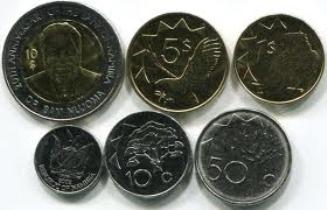The South African economy has a strong influence on neighbouring countries. At one point, Botswana, Namibia, Lesotho and Swaziland all used the South African rand as currency. Today, these countries together form the Southern African Customs Union, the world’s oldest, still surviving trade union. They have since adopted their own currencies, although the rand is still legal tender in all but Botswana.
Swaziland is a landlocked country in South Africa. Although the British recognized the autonomy of the Swaziland Nation in 1881, the country remained under the administration of South Africa for another 80 years. It was not until 1963 that Swaziland’s independence was written into law, when Britain promulgated the Swaziland independence constitution. The country held its first elections in 1964. Ten years later it issued its own currency, replacing the South African rand. In 1974 the lilangeni (plural “emalangeni”) was introduced as the currency of Swaziland. It is subdivided into 100 cents. The lilangeni is part of the Common Monetary Area, which means that it is pegged to the South African rand at a one-to-one exchange rate.

Lesotho is another landlocked country in South Africa. It was established by King Moshoeshoe in 1822. Over the next 40 years the people of Basutoland, as Lesotho was known, fought several wars with the Dutch colonists (the Boers) for control of land. King Moshoeshoe appealed to Queen Victoria for aid, and she agreed to make Basutoland a British protectorate in 1868. The country remained under British rule until 1966 when it was granted independence and became known as the Kingdom of Lesotho. In 1980 it introduced the Loti as the currency of Lesotho, replacing the rand. The Loti (plural “maloti”) is subdivided into 100 lisente. Lesotho is also part of the Common Monetary Area, so the Loti and the rand are both accepted as legal tender within Lesotho.

Namibia lies to the North of South Africa, bordering the Atlantic Ocean on the West. In the 19th century traders and settlers arrived in the country, mainly from Germany. It became a German colony in 1884 and was known as German South-West Africa. South Africa occupied the country in 1915 after defeating the Germans in World War I, when the country’s name was changed to South-West Africa. It was never officially incorporated into South Africa, but was instead administered as a ‘fifth province’. It gained independence from South Africa in 1990, following an armed struggle, and became known as Namibia. The German Mark was the currency of German South West Africa between 1884 and 1915. The occupation by South Africa in 1915 replaced the Mark with the British pound. South African currency continued to be used within Namibia until 1993 when the first Namibian dollars were issued. The rand is still legal tender in Namibia and can be exchanged on a one-to-one basis within the country.

Botswana is a landlocked country bordering South Africa, with Namibia to its East and Zimbabwe to the West. In the 19th century the Tswana people were engaged in a conflict over land with the Boers and the Ndebele people. The British government offered the Tswana protection in 1885 and the area was named Bechuanaland. The northern part of the country remained under the administration of the British while the southern territory became part of South Africa. When the Union of South Africa was formed in 1910, it was intended that Bechuanaland be incorporated into South Africa as part of a plan to bring together the main British colonies in the region. This plan never materialized. Instead, the British granted the country independence in 1966, when it was renamed Botswana. It would take another ten years before Botswana introduced its own currency. The pula was first issued in 1976, replacing the South African rand at par. The pula is subdivided into 100 thebe.



